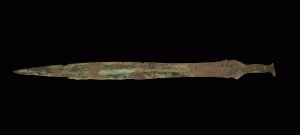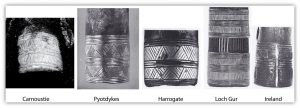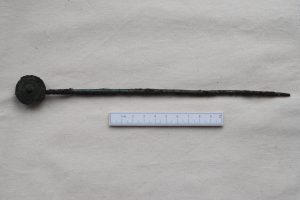 In January 2018, the specialist post-excavation analyses of the Carnoustie hoard was collated into a report by Alison Sheridan. This revealed that the sword had been wrapped in a woolen blanket or cloak when it was buried. The leaf-shaped bronze sword is classed as a Ewart Park type. Radiocarbon dates for Ewart Park phase metalwork in Scotland are sparse; the Carnoustie date of around 1000 BC is valuable new knowledge, which extends this phase of metalwork backwards in time than the 900–800 BC date bracket usually attributed for Ewart Park metalwork.
In January 2018, the specialist post-excavation analyses of the Carnoustie hoard was collated into a report by Alison Sheridan. This revealed that the sword had been wrapped in a woolen blanket or cloak when it was buried. The leaf-shaped bronze sword is classed as a Ewart Park type. Radiocarbon dates for Ewart Park phase metalwork in Scotland are sparse; the Carnoustie date of around 1000 BC is valuable new knowledge, which extends this phase of metalwork backwards in time than the 900–800 BC date bracket usually attributed for Ewart Park metalwork.
 The spearhead had been wrapped in sheepskin when it was buried with the sword. The leaf-shaped bronze spearhead is of Type 11A in the latest typology of British Late Bronze Age spearheads and is among the longest examples of its type. There were no traces of wood (from a shaft) in its socket. Compositional analysis of the bronze of the spearhead, undertaken by Peter Northover, revealed that it comprises 86.7% copper, 11.4% tin and 0.68% lead, with trace amounts of several other elements. Lead isotope analysis by Jane Evans and Vanessa Pashley of the Natural Environment Research Council revealed that the lead probably originated in a central English ore field. Compositional analysis of the gold by Lore Troalen from National Museums Scotland revealed the gold to be of high purity, and lead isotope analysis of the gold showed that it grouped with southern Irish and southern British ore compositions. An origin of the lead content in an English ore field seems likely.
The spearhead had been wrapped in sheepskin when it was buried with the sword. The leaf-shaped bronze spearhead is of Type 11A in the latest typology of British Late Bronze Age spearheads and is among the longest examples of its type. There were no traces of wood (from a shaft) in its socket. Compositional analysis of the bronze of the spearhead, undertaken by Peter Northover, revealed that it comprises 86.7% copper, 11.4% tin and 0.68% lead, with trace amounts of several other elements. Lead isotope analysis by Jane Evans and Vanessa Pashley of the Natural Environment Research Council revealed that the lead probably originated in a central English ore field. Compositional analysis of the gold by Lore Troalen from National Museums Scotland revealed the gold to be of high purity, and lead isotope analysis of the gold showed that it grouped with southern Irish and southern British ore compositions. An origin of the lead content in an English ore field seems likely.
 The Carnoustie spearhead is one of only five examples of spearheads adorned with gold binding in Britain and Ireland, the others being from Pyotdykes near Dundee, Harrogate in Yorkshire, Lough Gur in County Limerick in south-west Ireland and another from Ireland.
The Carnoustie spearhead is one of only five examples of spearheads adorned with gold binding in Britain and Ireland, the others being from Pyotdykes near Dundee, Harrogate in Yorkshire, Lough Gur in County Limerick in south-west Ireland and another from Ireland.
 A complete but fragmented bronze sunflower-headed, swan’s neck bronze pin was found lying over the pommel, hilt and upper blade area of the sword, its head at the pommel end. Fragments of woven textile were associated with this pin, including in the narrow area between the shank and the back of the pinhead – thereby indicating that the pin had been used to securing the woolen cloth wrapped around the sword. Compositional analysis using X-ray fluorescence revealed that the pin, like the sword and the spearhead, is of leaded bronze.
A complete but fragmented bronze sunflower-headed, swan’s neck bronze pin was found lying over the pommel, hilt and upper blade area of the sword, its head at the pommel end. Fragments of woven textile were associated with this pin, including in the narrow area between the shank and the back of the pinhead – thereby indicating that the pin had been used to securing the woolen cloth wrapped around the sword. Compositional analysis using X-ray fluorescence revealed that the pin, like the sword and the spearhead, is of leaded bronze.
 The fragments of textile were examined by Susanna Harris of the University of Glasgow using scanning electron microscopy, who concluded that all were of sheep’s wool, and that at least two different textiles were represented. One, found around the socket of the spearhead is a fine, tabby weave, woven using z-spun thread with one thread system finer that the other. The other, found associated with the pin and the annular mount that decorated the scabbard, is a slightly coarser fabric, woven with z-spun yarns with thread systems of similar diameter. There is no sign of any dye in either fabric.
The fragments of textile were examined by Susanna Harris of the University of Glasgow using scanning electron microscopy, who concluded that all were of sheep’s wool, and that at least two different textiles were represented. One, found around the socket of the spearhead is a fine, tabby weave, woven using z-spun thread with one thread system finer that the other. The other, found associated with the pin and the annular mount that decorated the scabbard, is a slightly coarser fabric, woven with z-spun yarns with thread systems of similar diameter. There is no sign of any dye in either fabric.
The fact that a very similar deposit was found at Pyotdykes, just 20 km to the west of Carnoustie is remarkable. Along with numerous other finds of Late Bronze Age metalwork in Tayside and Fife, this attests to the wealth of the Late Bronze Age elite in this part of Scotland. The Pyotdykes deposit comprised two swords (with traces of a composite wood and animal skin scabbard associated with one) and a gold-bound spearhead.
